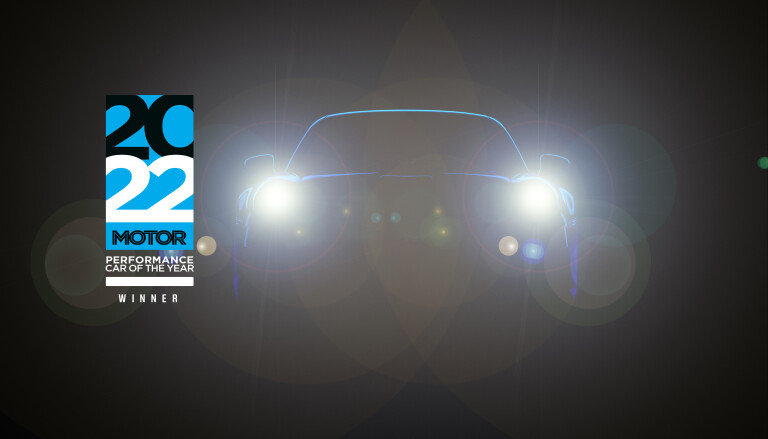
Predictable? Maybe. Fully deserved? Beyond any reasonable doubt. Hail the Performance Car of the Year 2022 champion – the Porsche 992 911 GT3
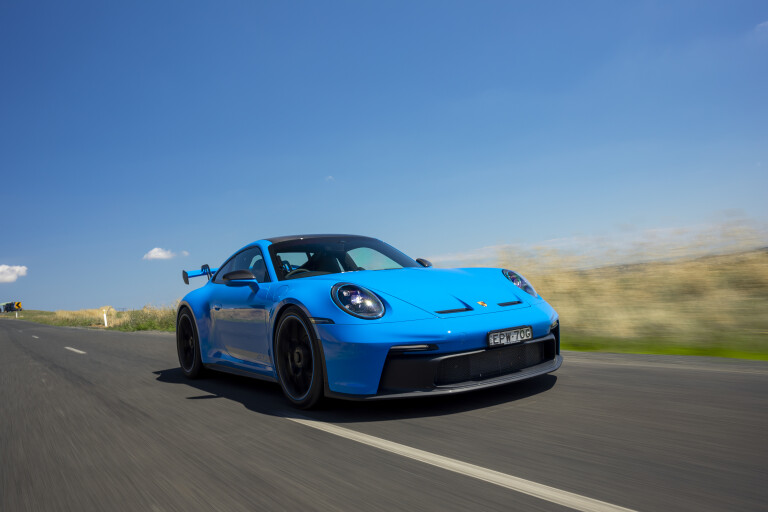
Excellence can look a lot like perfection. You only have to look at launch reviews of the Porsche 911 GT3 as a case in point. Each generation, whether it’s the 996 generation of 1999, the 997 of ’06, or the 991 of ’13, established itself as the best driver’s car in its class. And because, in each instance, there was nothing better to measure it against, perhaps it’s understandable that their individual shortcomings only coalesced over time.
Of course, given the way that cars are developed, Porsche is already at work on the next car and understands that the car that arrives box-fresh in dealerships can be improved in very specific ways. As ex-Porsche engineer and now Williams F1 boss Jost Capito has said, he never wanted to buy a car that he’d developed, because by the time it was launched it was an old car and he knew that something better was on the way.
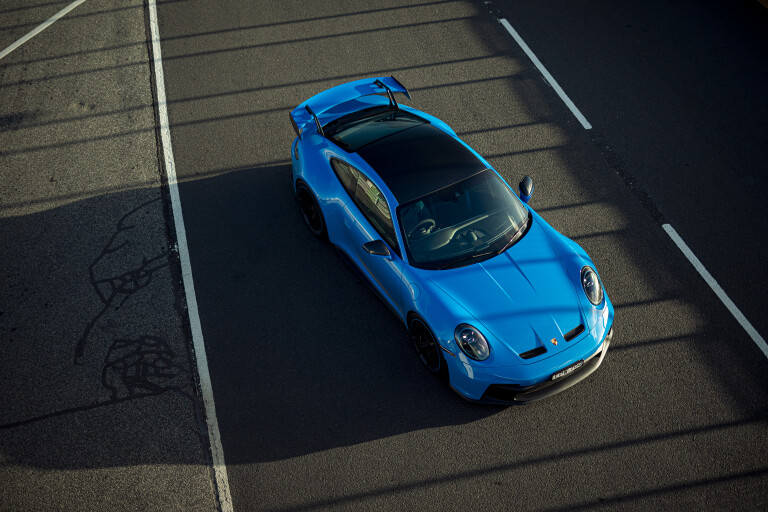
Even knowing all of this, watching judges emerge from the Porsche 992 GT3 at this year’s Performance Car of the Year was instructive. Depending on how demonstrative the personality, there was a curious mix of elation, admiration and shoulder-shrugging resignation, the latter because it was clear that the pre-event favourite had just annihilated the rest of the field. Kirby climbed out, stood with hands on hips and then muttered “it’s just so annoyingly good”. PCOTY ’22 wasn’t a competition as a result: it was more of a demonstration event.
Every judge placed the 992 GT3 in first place on their list of preferences, the margin of victory reminding us why Porsche has been victorious in 16 of 26 PCOTY events, the 911 in particular claiming 13 overall wins. Some years, PCOTY is a judging wrangle, an exercise in trying to tease out the subtleties of subjective and objective preferences. Not this year.
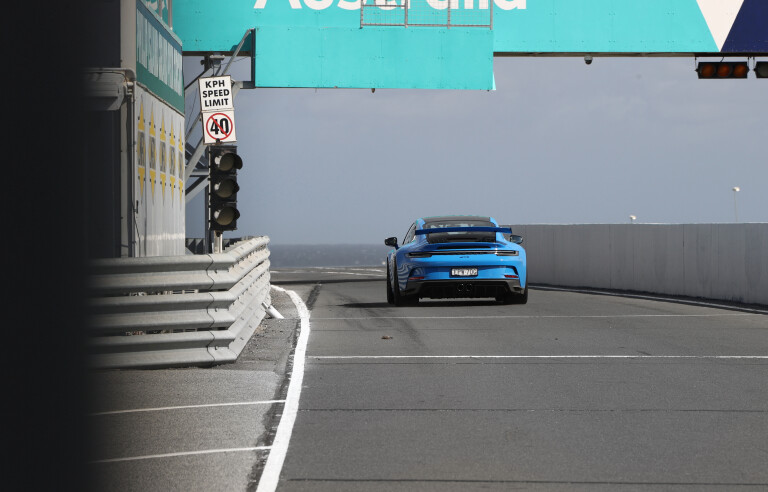
We will say this. If you look at this year’s PCOTY as a guide to buying a road car that you rarely if ever intend to take on track, don’t waste your $369,600 on a 911 GT3. Spend ninety grand less on a 911 Carrera S (PCOTY winner of 2020) and you will be rewarded with a more rounded road car; possessed of more torque, far superior cabin refinement and ride quality that’s significantly friendlier.
As with prior generations, the GT3 is a track-oriented vehicle that works on road the closer the road resembles a track. That’s why we asked for the PDK-equipped version. Faster, crisper, more aggressive and capable of wringing every last rev out of the engine before upshift, it’s a transmission that suits the GT3’s persona better than a six-speed manual. Porsche’s Andreas Preuninger, father of this vehicle, is pretty unequivocal on that score.

Some reviews have suggested that this 992 version of the GT3 has become a little too focused for its own good to work as a road car. We’d take issue with that. Yes it is loud and firm, clumsy even at low speed, but it finds a just about legal cadence where it flows acceptably, shucking off that low-speed recalcitrance. The new double-wishbone front end coupled with changes to the electrically assisted power steering introduces a newfound delicacy to the way the GT3 steers. It now tips sweetly into cambers, the wheel guiding into the dish of a corner by a few degrees. It’s reminiscent of a late model Exige, and that’s a huge compliment.
Because a MacPherson strut setup directs the braking force into the shock absorber, Porsche has traditionally relied on a very stiff front unit for the GT3. Because the damper now sits between two forged aluminium wishbones, Weissach has considerably more scope to elegantly tune it without having to burden it with a stack of anti-dive requirement.
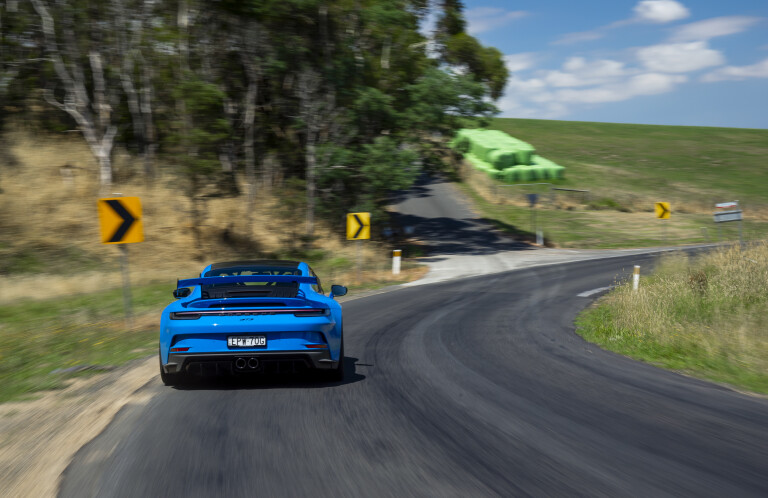
Don’t read too much into the fact that front spring rates have gone up from 40 to 100N/mm. Due to the change in front suspension, these are apples and oranges measures, the increase in spring rate being offset by the square of the motion ratio and the spring angle to result in a modest increase in actual wheel rate. From the seat of the pants, it doesn’t feel night and day stiffer than the 991.2 GT3 and is certainly more yielding than the 991.2 GT3 RS.
The typical 911 front end bob and susceptibility to mid-corner understeer (via squat) have been massaged away a little. On really poor roads, however, it can become very lively and you’ll need to keep an eye open for tarmac deformations that can send the front end into sudden and full compression. The same could be said for many supercars.

Admittedly, I did jump into the GT3 after emerging from the Taycan for the road loops, but it is loud. Porsche’s current philosophy with its GT cars is to manage exterior noise, primarily from exhaust to satisfy drive-by regulations, but amp up cabin sound effects. This has an interesting effect. Whereas in the 991 GT3, you felt you absolutely had to chase the redline to get that sound, in the 992 you’re rapidly saturated in decibels.
It deepens at 4000rpm, gets angry from 5000 and just swells through the peak torque point of 6100rpm. Going for the redline – and remember that this model makes peak power at 8400rpm – feels utterly illicit on road. Pair that with the vibrations and racket from the cage in this Clubsport-equipped car and it makes any open-road trip feel a deeply immersive event. You can even hear the rear dampers exhale like a boxer flicking out a jab.
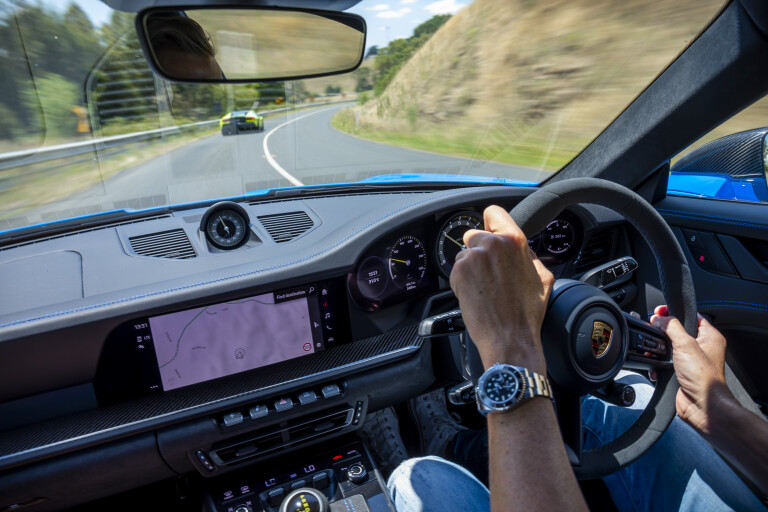
Exhilarating is good, but it’s not enough to win PCOTY. The Audi R8 V10 and the Mercedes-AMG A45 S both delivered that last year but failed to ascend to the top step. After the road loops, the GT3 wasn’t miles ahead of the rest of the pack, but the fact remains that it only needed to be there or thereabouts given what was in store. Phillip Island, you see, is just about the perfect circuit for the 992 GT3. Beautifully surfaced and fast, with flat-chat corners where the aero could get to work and tight ones where the redesigned four-wheel steer could rotate the nose sharply, the only question that needed to be answered was whether the Porsche could run down the lap time of the Lamborghini, the latter wielding a healthy 95kW/130Nm advantage plus the tractive benefit of all-wheel drive.
The VBOX doesn’t lie, and the GT3 was fully 3.35sec quicker. Sure, some of the Porsche’s lap time advantage can be put down to tyre choice but overcoming a 70kW/tonne power-to-weight deficit is jaw-dropping.
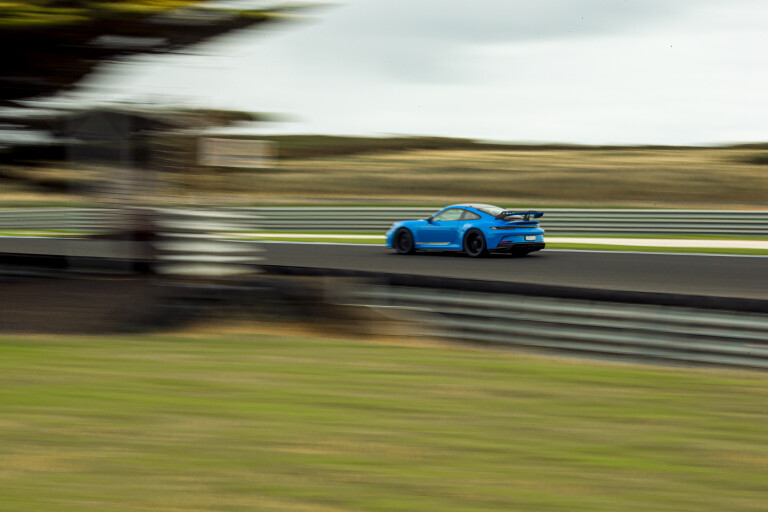
What’s most impressive about the GT3’s performance on track is that it offers such a seamless choice between chasing a lap time while driving in a fully disciplined manner and performing like an utter hooligan. I’d have enjoyed a little more heft to the steering, but that’s a personal observation and I’m probably an outlier in that regard. On both road and track, rear visibility in this caged car is terrible, the combination of roll cage, carpeted shelf and rear spoiler obscuring the view of most everything behind. If you have a car appearing in your rear-view on track, you’re probably not trying hard enough.
Brake calibration is near-perfect, the standard iron discs (408mm front and 380mm rear) delivering superb pedal modulation through a relatively generous pedal arc. Power? Well, we’ve had much the same power in a GT3 ever since the 997 GT3 RS 4.0 over a decade ago and it’s genuinely ample. You never emerge asking for more horses. Even Bernie Quinn, who likes a reassuring surfeit of Newton metres to play with noted that “the powertrain is not overwhelming with respect to torque, but the power is vast and the top end huge and dramatic.”
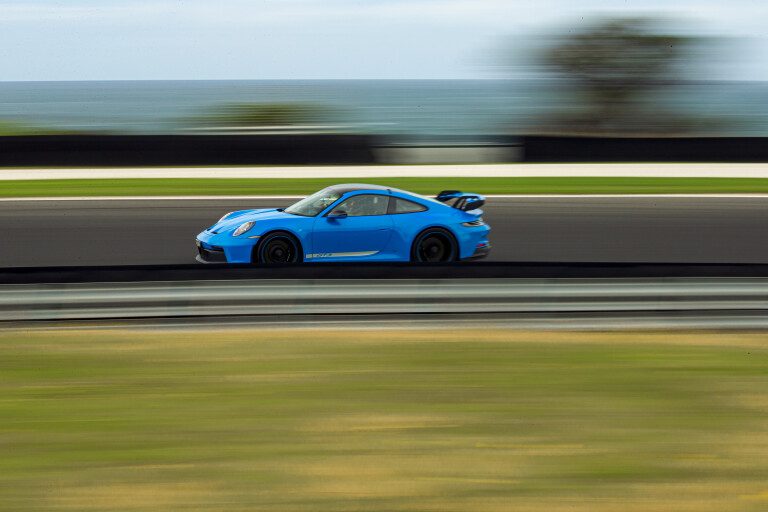
It’s not perfect. Had Mercedes-AMG fronted up with an AMG GT Black Series, the 992 GT3 wouldn’t have been the fastest. That said, we can’t think of another PCOTY champ that dominated the competition so demonstratively. Its superiority was never in doubt. The suite of incremental changes that Weissach has wrought upon this car have resulted in a package that, for now, seems unbeatable.
Of course, Porsche knows what’s in the works for the second generation of this car and is already aware of its relative deficiencies. That’s slightly scary. But until then, the 992 GT3 is as close to perfect as we’ve ever driven and Performance Car of the Year has never had a worthier winner.

The judges' comments
Alex Affat
“Turn-in on corner entry feels almost telepathic such is the responsiveness of its razor-sharp front end.”
Ranking: 1st
Andy Enright
“How capable is the GT3? Every judge could lap faster in this than Walter Röhrl in a 997 GT3. Let that sink in.”
Ranking: 1st
Trent Giunco
“Given how the GT3 drives on track, you’d think your fillings would rattle out on road, but no.”
Ranking: 1st
Cameron Kirby
“Luffy appeared around the last corner in the GT3 and was clearly going way faster than everything else.”
Ranking: 1st
Bernie Quinn
“The rear end feels like the tyres are two feet wide. Unbelievable levels of grip with no squidge.”
Ranking: 1st
Luffy's view
“I loved the gearbox in the GT3. Just flick it and it’ll jump gears. How are they ever going to improve it?”
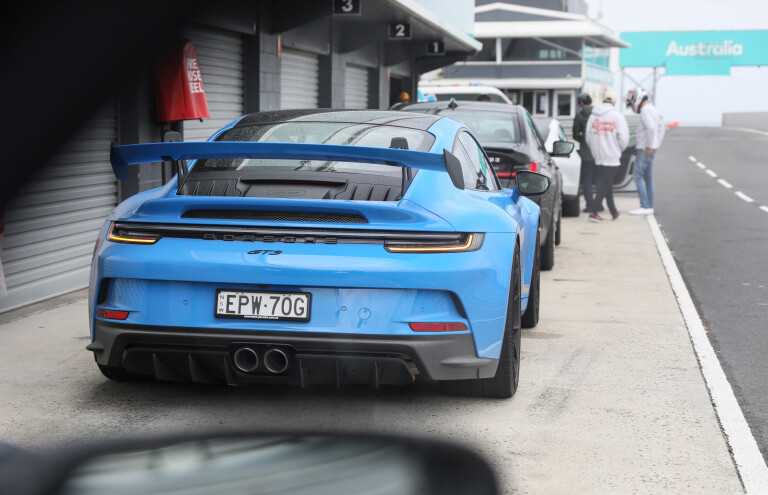
Key figures
| 0-100km/h: | 3.11 seconds |
|---|---|
| 0-400m: | 11.53 sec @ 203.86km/h |
| Lap time: | 1:39.74 |
The honour roll
Every PCOTY winner through the years
| 1996: | Porsche 993 Turbo |
|---|---|
| 1997: | BMW E36 M3 |
| 1998: | Porsche Boxster |
| 1999: | Porsche 996 Carrera |
| 2000: | Porsche Boxster S |
| 2001: | Nissan S15 200SX |
| 2002: | BMW E46 M3 |
| 2003: | Porsche Boxster S |
| 2004: | Lamborghini Gallardo |
| 2005: | Porsche 997 Carrera S |
| 2006: | Audi B7 RS4 |
| 2007: | Porsche 997 GT3 |
| 2008: | Porsche 997 GT2 |
| 2009: | Audi R8 V10 / Nissan GT-R |
| 2010: | Porsche 997 GT3 RS |
| 2011: | Nissan GT-R |
| 2012: | Porsche 991 Carrera S |
| 2013: | Audi R8 V10 Plus |
| 2014: | Porsche 991 Turbo |
| 2015: | Porsche 991 GT3 |
| 2017: | Porsche 991 Turbo S |
| 2018: | Honda Civic Type R |
| 2019: | Porsche 991 GT2 RS |
| 2020: | Porsche 992 Carrera S |
| 2021: | Mercedes-AMG GT R Pro |
| 2022: | Porsche 992 GT3 |



COMMENTS